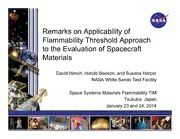
NASA Technical Reports Server (NTRS) 20140003551: Remarks on Applicability of Flammability Threshold Approach to the Evaluation of Spacecraft Materials PDF
Preview NASA Technical Reports Server (NTRS) 20140003551: Remarks on Applicability of Flammability Threshold Approach to the Evaluation of Spacecraft Materials
Remarks on Applicability of Flammability Threshold Approach to the Evaluation of Spacecraft Materials David Hirsch, Harold Beeson, and Susana Harper NASA White Sands Test Facility Space Systems Materials Flammability TIM Tsukuba, Japan January 23 and 24, 2014 Agenda • Review of reasons for the current NASA STD Test 1 modifications – Flammability threshold vs. pass/fail in given environments – True threshold vs. ULOI or LOI (Extinguishment vs sustained flaming combustion) • Summary of existing ground flammability threshold test data • Considerations for selection of materials for ISS experiment Flammability Threshold vs Pass/Fail • Evaluation of flammability threshold allows: – Quantitative correlations between ground and microgravity or reduced gravity data – Closer evaluation of flammability safety factors – Flexibility for spacecraft environment selection – Identification of materials with increased flammability risk from oxygen concentration or total pressure changes to minimize their potential safety impact Flammability Threshold vs Pass/Fail – Flammability thresholds also allow for: • Development of sound requirements for new spacecraft and extravehicular landers and habitats • Evaluation of flammability parametric effects (i.e. pressure, oxygen concentration, thermal radiation, sample geometry, etc) True Threshold vs ULOI or LOI • Spacecraft material engineers may want to know the range of conditions where materials are safe from a flammability point of view and for fire risk management both under normal and special operating conditions (i.e. emergency operations, etc.) when space cabin environment changes could occur. • An MOC (Maximum Oxygen Concentration) has been defined keeping spacecraft material engineers in mind. It is the maximum oxygen concentration under which extinguishment would occur, thus providing the upper limit for safe fire conditions True Threshold vs ULOI or LOI • LOI is commonly defined as the minimum oxygen concentration under which flaming combustion occurs (in an upward flowing oxygen/nitrogen mixture). Consequently, it does not provide extinguishment limits or a true flammability threshold. • Consequently, the usage of MOC has been recommended for space systems fire safety, although both the upward limiting oxygen index and the MOC are determined. True Threshold vs ULOI or LOI • As with all flammability testing, we should keep in mind that the MOC is expected to depend on sample geometry, thickness, ignition mode, radiant energy, pressure, gravity level, etc. Therefore, we recommend mentioning conditions under which the MOC is determined • The MOC data to date has been obtained under conditions closely resembling NASA STD 6001 Test 1, to allow continued usage of its database. Pressure Effects on MOC Thickness Effects on MOC for Silicone 25 24 23 22 21 C O 20 M 19 18 17 16 15 0 0.005 0.01 0.015 0.02 0.025 0.03 0.035 0.04 Thickness (in.) Ignition Source Effects on MOC 30 25 20 PET C PEI O 15 MQ, 0.040 in. thick M MQ, 0.024 in. thick PI 10 PEEK PMMA, extruded, ¼-in. dia rod 5 0 Chemical Hot-Wire Method of Ignition
